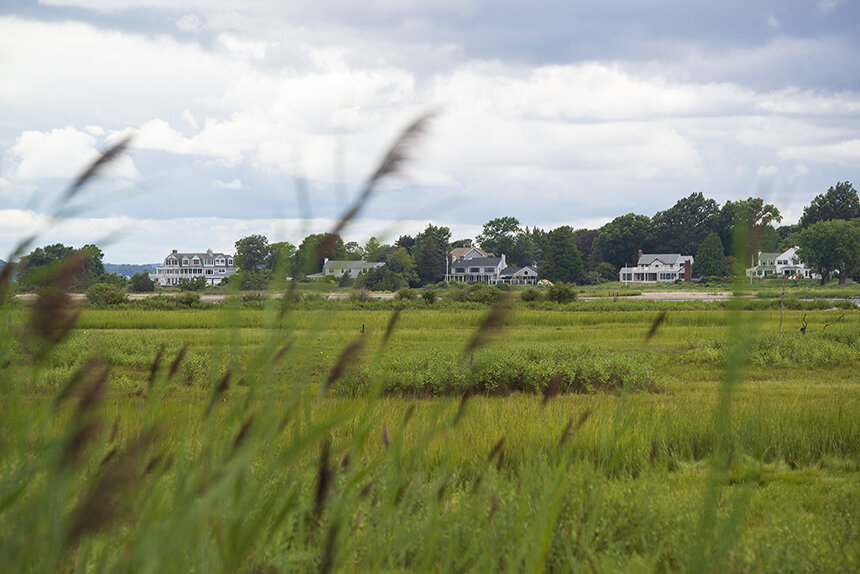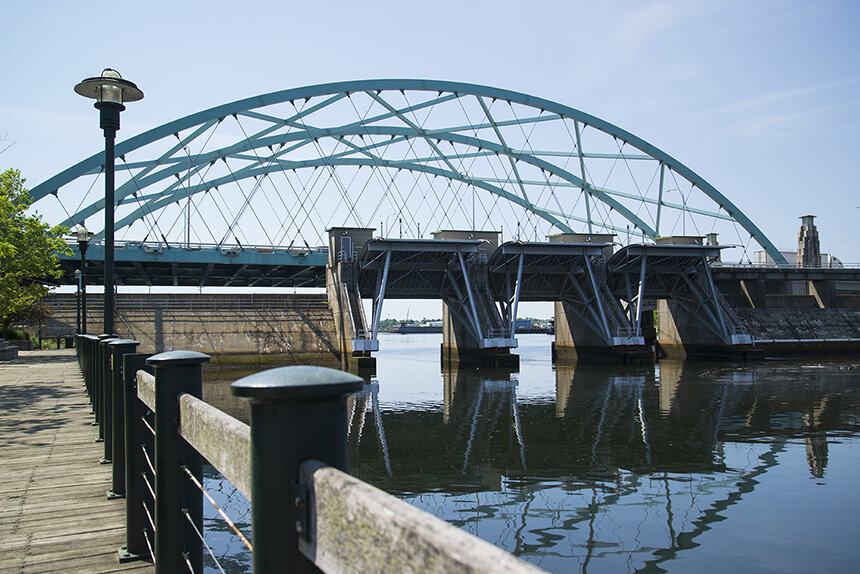Priceless Space Where Land Meets Sea is Slowly Drowning
Rhode Island’s salt marshes provide habitat, storm buffering and carbon sequestration
August 21, 2021
“To stand at the edge of the sea, to sense the ebb and flow of the tides, to feel the breath of a mist moving over a great salt marsh, to watch the flight of shore birds that have swept up and down the surf lines of the continents for untold thousands of years, to see the running of the old eels and the young shad to the sea, is to have knowledge of things that are as nearly eternal as any earthly life can be.” — Rachel Carson
Rhode Island’s salt marshes are magical places. They are where land meets sea, liminal areas where you can hear both the chirping of crickets and the caw of seagulls. Oysters and mussels sit warm in the brackish mud.
The Jacob’s Point Preserve on the Bristol-Warren line is one of these special places. It is the flagship property of the Warren Land Conservation Trust.
It was a breezy but warm fall morning and Scott Ruhren, senior director of conservation for the Audubon Society of Rhode Island, walked along the boardwalk that leads toward the 37.6-acre marsh, which sits between the East Bay Bike Path and the Warren River.
As we walked, he pointed out various native and invasive plants, the skeletons of tupelo trees that remain after a 10-mile brushfire ripped through the marsh in 2008, and an old farming path that tramples through the rushing phragmites.
When we meandered into the coastal flatlands of the marsh, Ruhren stepped off the path and headed over to a patch of rusty-red sea pickle. “This is edible,” he said, picking a few ends of the succulent plant. “It has a salty flavor, and turns this beautiful red in the fall.”
Seaside goldenrod bends in the ocean breeze, and Ruhren spotted what he thought could be the elusive and endangered saltmarsh sparrow flitting through cordgrass.
“This is one of the spots they’re doing incredibly well,” he said. “But if the salt marshes go away and sea level rises faster, it could disappear. It’s a sad story.”
But the saltmarsh sparrow isn’t the only species in danger if sea levels continue their accelerated rise. You see, salt marshes are more than just diverse brackish ecosystems. They are more than stinky, slimy, mucky patches of water-land. They are also natural buffers that protect land from sea. They’re priceless.
“From a sea-level rise standpoint, they absorb tons of energy,” Ruhren said. “We have a couple coastal refugees around the state and after big storms like Sandy or Irene, people always think the salt marshes are going to be wiped out, but the natural salt marshes survive those events better than human landscapes. For example, when Misquamicut was wiped out, a lot of the buildings were gone, but the marsh itself absorbed the impact. So, it’s like the first line of defense for the inland habitats.”
But this defense is at risk. As sea levels rise and as human development hardens the land along the coast, salt marshes are running out of room to adapt. They are on a path toward functional extinction. As they drown, the vital services they provide — habitat, storm buffering and carbon sequestration — will also disappear.
In fact, the loss of coastal wetlands is one of the biggest causes of permanent landscape alteration in the United States. Rhode Island, for example, has already lost more than 50 percent of its original salt marsh habitats during the past two centuries because of human activities.
“We’re dealing with two things with salt marshes in Rhode Island,” Ruhren said. “It’s all the manmade issues and disturbances, and then the lack of sediment building up in the marsh like it normally would, which is compounded by more frequent storms and sea-level rise.”
Salt marshes are getting squeezed out, with sea water encroaching on one side and humans on the other. And Jacob’s Point, while a relatively healthy example of a salt marsh, has a history of human-induced degradation.
“The path that the Warren Land Trust uses to get out to the water was actually built by a landowner who lived up hill, and he used to bring a seaplane in and bring in supplies that way,” Ruhren said. “That path led to a lot of the problems on the marsh because there were stone culverts — probably early 20th century — and one by one the stone culverts started to collapse … and created an impoundment on the south side of the marsh. And what you want in a salt marsh is that twice day flushing of the salt water. If you don’t get that, you start to get the degradation.”

Another sign of human meddling that could have impacts in the future is the sprawling private neighborhood development up the hill from the salt marsh. Also called Jacob’s Point, it’s an example of the hardening of the shoreline, an area once wild being taken over by cookie-cutter houses with manicured, chemical-green lawns.
It’s quite the contrast to the wild, unkempt scraggle of the salt marsh below.
“I always like to use Connecticut as an analogy,” Ruhren said. “When you drive up [Interstate] 95, they pretty much have a hardened shoreline all the way up. We’re trying to avoid that.”
To combat the further loss of these important coastal ecosystems, various state agencies have worked together to assess and save salt marshes. In 2016, the Coastal Resources Management Council (CRMC) released a Rhode Island Salt Marsh Monitoring and Assessment Program (SMMAP) that “presents a strategy for developing a comprehensive, statewide monitoring and assessment program.”
In essence, SMMAP is triage for salt marshes.
“A lot of the salt marshes have been assessed to try to determine which ones are worth saving,” Ruhren said. “Because one that is so horribly degraded, well, it doesn’t pay to work on it.”
Besides building modern culverts and enhancing marsh elevation with dredge materials, the best way humans can reverse the wrong we have wrought on salt marshes — and in the process help our species survive — is simple: preserve land.
“Ideally the best thing to do is to save land, and land right from the marsh, which is not always possible because it’s such a built-up shoreline,” Ruhren said. “That allows for salt marsh migration, because salt marshes naturally move, and with sea-level rise, if they don’t have a place to move inland, they’re just going to be squashed and shrink and shrink more.”
Editor’s note: For more information about climate-change impacts on salt marshes, check out this video from retired University of Rhode Island professor and naturalist Gerald Krausse.




New HAMPSHIRE: "The Great Bay Living Shoreline Project aims to create new living shoreline projects in the Great Bay Estuary that protect salt marsh habitat and coastal communities from erosion, sea level rise, and flooding." From https://www.nhcaw.org/greatbaylivingshorelineproject/